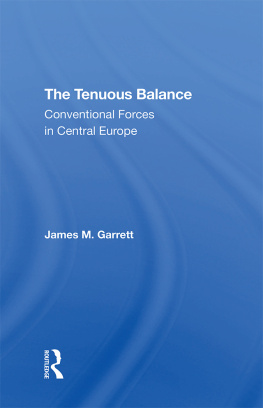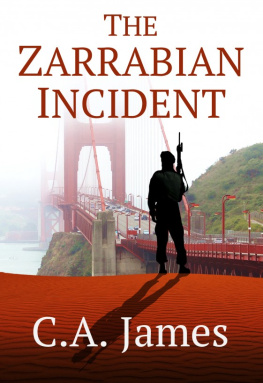First published 1989 by Westview Press, Inc.
Published 2019 by Routledge
52 Vanderbilt Avenue, New York, NY 10017
2 Park Square, Milton Park, Abingdon, Oxon OX14 4RN
Routledge is an imprint of the Taylor & Francis Group, an informa business
Copyright 1989 Taylor & Francis
All rights reserved. No part of this book may be reprinted or reproduced or utilised in any form or by any electronic, mechanical, or other means, now known or hereafter invented, including photocopying and recording, or in any information storage or retrieval system, without permission in writing from the publishers.
Notice:
Product or corporate names may be trademarks or registered trademarks, and are used only for identification and explanation without intent to infringe.
Library of Congress Cataloging-in-Publication Data
Garrett, James M.
The tenuous balance: conventional forces in central Europe /
James M. Garrett
p. cm.
Includes bibliographical references.
ISBN 0-8133-0941-7
1. Central EuropeDefenses. 2. North Atlantic Treaty
OrganizationArmed forces. 3. Warsaw Treaty OrganizationArmed
Forces. I. Title.
UA646.8.G37 1989
355'.03304dc20 89-38401
CIP
ISBN 13: 978-0-367-29648-3 (hbk)
The instigation for this book was my doubt that the political and military confrontation in Central Europe would remain stable in a serious crisis. Uncertainty of success may deter Soviet risk-taking forty-nine years out of fifty but not in that fiftieth year if Soviet leaders should face an apparent threat to their continued hegemony in Eastern Europe or an opportunity to settle their European power problem once and for all. If nuclear weapons deter only each other, crisis stability depends upon NATO's appearing able to ward off invasion by conventional forces.
Published analyses do not offer convincing judgments about the ability of either party in Central Europe to achieve its wartime purpose once deterrence fails. Previous works are of three kinds. Some are useful analyses of such particulars as artillery. Others render overall judgments without adequate consideration of particulars. The rest are attempts to achieve mathematical precision by comparing such tangibles as firepower while unavoidably omitting other factors that cannot be measured.
There are good reasons for the dearth of defense analyses that attempt to integrate all relevant factors. Dependable data about intangibles are spotty and hard to come by. The validity of syntheses must always remain doubtful because too many judgments are involved that cannot be proved and cannot be reduced to mathematical certainty and precision. An author with the temerity to try to justify a synthesis of tangible and intangible factors must anticipate objections by both expert particularists who reject his judgments on such specifics as the actual tank-killing capacity of guided missiles and generalists who suspect him of missing the forest for the trees.
This study does not aspire to be definitive. The confrontation is too fluid; understanding it involves too many tenuous judgments to support unchallengeable conclusions. However, the balance is amenable to analysis, and I have tried to point the way toward refinement of our understanding. As a holistic appraisal of the conventional military situation in Central Europe, the book points to many relationships of factors that need to be explored further and more accurately than they have been in the past.
I have relied for counts of weapons and units largely on the annual issues of The Military Balance, whose compilers I acknowledge to be quite conservative in accepting new data. However, different problems arose in evaluating intangibles such as states of training, quality of maintenance, lan, leadership, and unit cohesion. Published commentary is both subjective and selective, and much of the harder evidence is episodic. Aside from the British Falklands action and an occasional French foray in Africa, there is little hard evidence of the quality of forces of either superpower's allies. Most of what does exist consists of superficial comments by casual observers, suspect opinions of deserters and defectors, and possibly meaningless results of competition between weapons crews from NATO's national forces. In sharp contrast, there is a great deal of negative information about the quality of U.S. forces and some similar indications about Soviet forces. However, the flaws of both superpowers' forces are those common to all armed forces in all times, both those that have failed and those that have succeeded. Thus, my conclusions about forces' comparative quality, like my more general conclusions, are necessarily tentative.
I have intended this study both for specialists with policy responsibilities and for those in and out of government and academia who have intellectual concerns with defense and are willing to plough through detail and through sometimes complex arguments. The book may serve both as a resource for policy makers and as a germinal study for scholars. I have tried to lay the foundation for a much needed rethinking and restructuring of NATO military policy. I have also tried to provide the conceptual basis for developing arms control objectives that are consistent with effective deterrence. Moreover, I hope the book will inspire mathematically inclined analysts to try to build models that encompass hard-to-measure factors. I have in addition avoided technical jargon in order to keep the book within the grasp of serious non-specialist readers.
The book is also a plea to the western allies to take conventional deterrence seriously, which they have never done. They need to develop a posture based upon objective and rational analyses of the relationships among various tangible and intangible factors in place of the existing agglutination of ill-thought-out policies that reflect a number of diverse and incompatible parochial viewpoints. Instead of simply aping the Russians, as western military planners are inclined to do, they should start over conceptually by asking themselves what specific posture is needed to deter invasion and what resources are really likely to be available.
My proffered solution is an area defense backed by substantial operational reserves, sufficient counterbattery firepower to prevent Pact artillery from neutralizing dispersed NATO anti-tank defenses, and sufficient tactical air power to gain and hold superiority in critical sectors. Defensible terrain exists even in flat north Germany, where this former ground soldier, impressed by once having seen an entire reinforced battalion combat team hidden in the sparse brush at Fort Sill, sees cover and concealment rather than a billiard table. I anticipate that the proposal will attract lightning.
No work of this scope is produced without help. I am indebted to Millersville University for numerous grants, released time, a sabbatical leave, and for the administration's tolerance of my taking several leaves of absence. I wish to thank members of the staffs of Ganser Library at Millersville and of the U.S. Army War College Library for their courteous and competent help. Elaine McDevitt and Armin Halle of NATO and Lt.-Col. David Pipe at SHAPE were very helpful in arranging a most enlightening interview with General Wolfgang Hlle. General Hlle was especially generous with his time and patient with my questions. He clarified several obscure points for me. Dominick Graham, Dale Herspring, A. Ross Johnson, Steven T. Ross, and Ivan Volgyes also guided me to useful sources. I must also acknowledge Steven Canby's path-breaking studies of the 1970s; most of his insights remain valid. Most of all, I am profoundly indebted to my colleague Shirley Garrett for her persistent, sharp challenges to my thinking, for the strong sense of order that she brought to her organizational suggestions, and for assiduously winnowing out many infelicitous phrases from the manuscript. The work's remaining flaws are, of course, my own responsibility.












